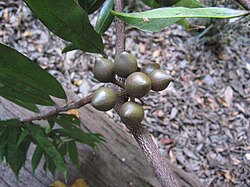Biology:Pseudoxandra lucida
| Pseudoxandra lucida | |
|---|---|

| |
| Photograph of Pseudoxandra lucida with fruit.[1] | |
| Scientific classification | |
| Kingdom: | Plantae |
| Clade: | Tracheophytes |
| Clade: | Angiosperms |
| Clade: | Magnoliids |
| Order: | Magnoliales |
| Family: | Annonaceae |
| Genus: | Pseudoxandra |
| Species: | P. lucida
|
| Binomial name | |
| Pseudoxandra lucida R.E.Fr.
| |
| Synonyms | |
|
Cremastosperma guianense R.E.Fr. | |
Pseudoxandra lucida is a species of plant in the family Annonaceae. It is native to Bolivia, Brazil , Colombia, Peru, and Venezuela.[1] Robert Elias Fries, the Swedish botanist who first formally described the species, named it after its shiny (lucidus in Latin)[3] leaves.[4]
Description
It is a tree reaching 3 to 20 meters in height. Its shiny leathery leaves are 7-20 by 2–6.5 centimeters and come to a point at their tips. The leaves are hairless on their upper and lower surfaces, but can have small warty bumps. The leaves are green, greenish brown or dark brown above and brown on their underside. Its petioles are 5-8 millimeters long. Its flowers are solitary or in pairs and axillary. Each flower is on a pedicel 2-5 millimeters long. Its flowers have 3 oval-shaped sepals that are 1.5-3 by 3-5 millimeters. The outer surface of the sepals is densely hairy. Its 6 petals are arranged in two rows of 3. The outer petals are pale green to yellow and 8-11 by 6-10 millimeters. The outer petals are densely hairy on their outer surface. The inner petals are similarly colored, 7-14 by 5-7 millimeters, and concave. The inner petals are smooth on their outer surface except for a hairy patch running from the tip to the base. It has numerous stamens that are 2–3.5 millimeters long. Each flower has 2-20 monocarps that are red, orange, purple or black at maturity and 9-14 millimeters wide. Its brown seeds are 8-12 by 9-11 millimeters.[5]
Reproductive biology
The pollen of P. lucida is shed as permanent tetrads.[6]
References
- ↑ 1.0 1.1 "Pseudoxandra lucida R.E.Fr.". The Trustees of the Royal Botanic Gardens, Kew. n.d.. https://powo.science.kew.org/taxon/urn:lsid:ipni.org:names:211622-2.
- ↑ Verspagen, N.; Erkens, R.H.J. (2021). "Pseudoxandra lucida". IUCN Red List of Threatened Species 2021: e.T146193566A146193581. doi:10.2305/IUCN.UK.2021-2.RLTS.T146193566A146193581.en. https://www.iucnredlist.org/species/146193566/146193581. Retrieved 20 June 2022.
- ↑ Stearn, William (2004). Botanical Latin. Portland, Ore. Newton Abbot: Timber Press David & Charles. ISBN 9780881926279.
- ↑ Fries, R.E. (1937). "Revision der Arten einiger Annonaceen–Gattungen IV" (in Latin, German). Acta Horti Bergiani 12: 222–231.
- ↑ Maas, Paul J.M.; Westra, Lubbert Y.Th. (2003). "Revision of the Neotropical genus Pseudoxandra (Annonaceae)". Blumea - Biodiversity, Evolution and Biogeography of Plants 48 (2): 201–259. doi:10.3767/000651903X674955. ISSN 0006-5196. http://www.repository.naturalis.nl/record/524896.
- ↑ Walker, James W. (1971). "Pollen Morphology, Phytogeography, and Phylogeny of the Annonaceae". Contributions from the Gray Herbarium of Harvard University 202 (202): 1–130.
External links
Wikidata ☰ Q15365952 entry
 |


